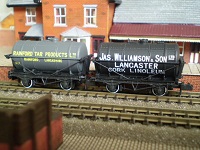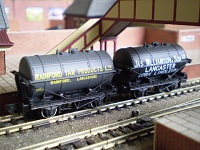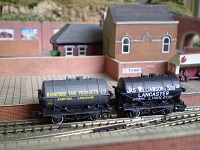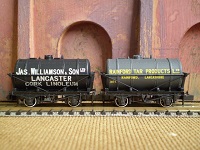Liquids of various kinds were carried by rail from the earliest days of the railway network, using the same barrels and
casks which previous generations would have loaded onto horse-drawn carts. But the iron horse could pull much bigger
loads, and specialist tank wagons were soon developed. The first generation of these were just rectangular metal boxes,
loaded up with six or seven tons of oil or whatever. But although they offered a big improvement in capacity, all that
liquid sloshing around meant that they were never very stable at any kind of speed. There had to be a better way,
and as the Victorian era drew to its close the railway engineers and designers came up with cylindrical tanks, using
new technology to fabricate a tank barrel by riveting curved sheets of metal together. The liquid inside has less
space to slosh around, so solving the stability problem at a stroke. These new-fangled wagons caught on in a big way,
and by the time of the 'Big Four' era in the 1920s they were starting to be a common sight on the railways of
Britain. More and more industrial customers were realising the financial benefits of having their own rail-connected
facilities with their own fleet of tank wagons, and two of these were the Lancashire companies of Jas.Williamson &
Son and Rainford Tar Products. The tank wagons bearing their names would have first run in the steam-hauled heyday of
the old London Midland & Scottish Railway back in the 1920s and 30s, but they built things to last in those days,
and the Williamson and Rainford tanks would have trundled on past the post-war nationalisation and into the BR steam
and green diesel era of the late 1950s and early 60s. Time and progress caught up with them in the end, of course,
like it caught up with the companies whose names they carried, and liquids on today's railways are carried in giant
bogie tankers holding 100 tons or more. But bring back the steam era on your layout with our Lancashire Tank Set,
and you'll say tanks for the memory.
Please note that these wagons are boxed individually.
|









